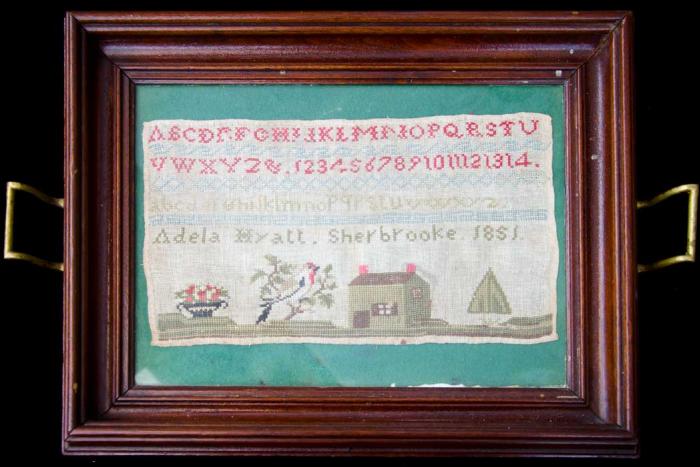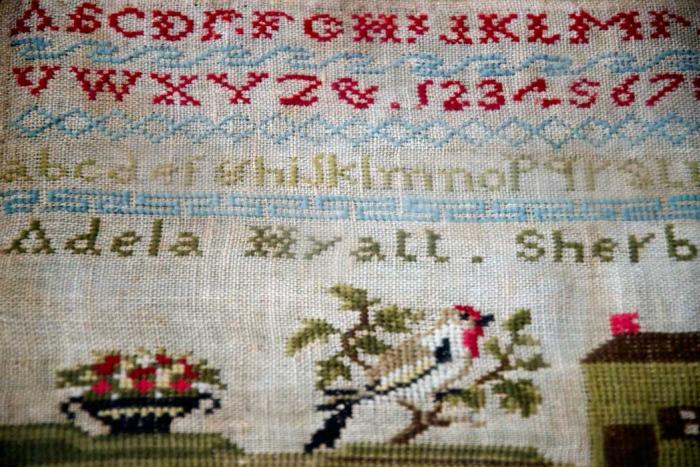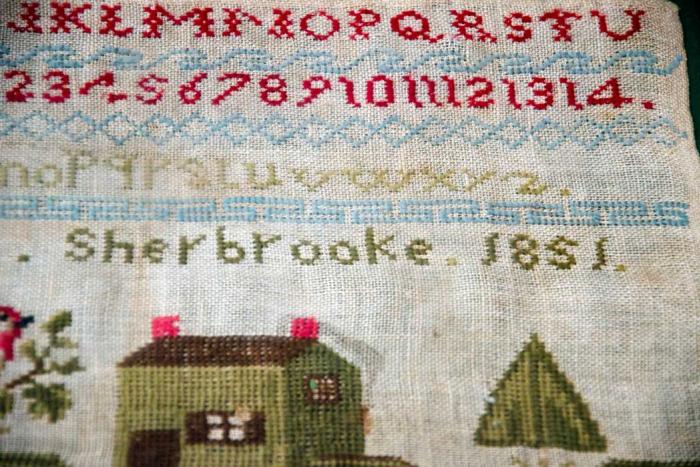Sampler by Adela Hyatt
Organization: Little Forks Branch UELAC & Patrimoine-Ascott-Heritage
Coordinates: http://townshipsheritage.com/organization/little-forks-branch-united-emp...
Address: 5955 Gilbert Hyatt Hwy., P.O.Box 67, Stn. Lennoxville, Sherbrooke, QC J1M 1Z3
Region: Estrie
Contact: Bev Loomis, mbloomis(a)live.com
Description: Needlework sampler made by Adela Hyatt in 1851, Sherbrooke, Quebec.
Year made: 1851
Made by: Adela Hyatt
Materials/Medium: Wool thread on linen
Colours: Multicoloured on natural field
Provenance: Sherbrooke, Quebec
Size: Sampler 20 cm x 35.5 cm; Sampler is under a 36.8 cm x 26.6 cm glass plate in a wooden serving tray measuring 40.6 cm x 49.5 cm
Photos: Rachel Garber. Courtesy Little Forks Branch UELAC & Patrimoine-Ascott-Heritage
Adela Hyatt’s Sampler
Brenda Hartwell
Adela Hyatt’s sampler (1851), hand-stitched with coloured wool thread on linen and preserved under the glass of a serving tray, is housed in the Archives of the Hyatt One-room Schoolhouse in Milby, Quebec. It is an artefact that takes us on a journey back in time to the days when the first pioneers were settling the Eastern Townships, and provides a window onto the history of early education in the region.
Following the American War of Independence, recently opened territory in the Eastern Townships experienced an influx of settlers from south of the border. Many popular histories have perpetuated the false assertion that most pioneers who came to Canada at this time were Loyalists. “Some came through a desire to live again under the British flag, but the greater portion was attracted by the free lands available” (Morrill). Although the majority of these uprooted Americans were not particularly patriotic, Adela’s grandfather, Abraham Hyatt Sr. was, indeed, a proud United Empire Loyalist, and he, along with his seven sons and three daughters moved from Arlington, Vermont, to St. Armand, Quebec, in 1784 (Coates).
Abraham’s son Cornelius was among Ascot Township’s first settlers. “Cornelius Hyatt received his letters patent for Lots 2 and 3 in Range IV - part of a 1200 Land Grant and came into Ascot in 1793” (Lowd). He cleared land near the banks of Moe’s River in what is now known as Milby. Adela, born in 1816, was the youngest of eight children born to Loyalist Cornelius Hyatt and his wife Parthenia Canfield.
Shortly after establishing a homestead that could sustain survival, these pioneers began to address the issue of education. “The New Englanders were deeply imbued with Calvinistic ideas of education, and in their home states much progress had been made along these lines.” … “The love of education was so inherent in the race that no sooner did the pioneers begin to find others settling round them than their instincts prompted them to begin schoolhouses” (Rennie).
The earliest record of a school in Milby dates from 1820, when “the people of the area subscribed to pay David Austin $36.00 to teach school for a term of twelve weeks. They had the option of paying him in salts of lye, wheat or corn” (Lowd).
Cornelius Hyatt donated a piece of land to the Royal Institution for the Advancement of Learning (established to provide a public school system), and a one-room schoolhouse was completed c. 1820s. Records show that between 1825 and 1895, attendance at the school averaged between 22 and 50 pupils (Lowd).
In the early days of the one-room schoolhouse, textbooks were rare and precious. While exploring the history of education in the Eastern Townships, Henry Rennie states that he examined dozens of early textbooks and “has found that in every case they were of American publication. Some of the very earliest Readers and Arithmetics were no doubt brought with the first settlers among their most cherished possessions.”
Certainly some American customs, such as needlework samplers, immigrated along with the textbooks. “Schoolgirl samplers are familiar and endearing embroidered textiles closely associated in the public consciousness with genteel female education, needlework artistry, and early American history” … “In the 18th century samplers became an integral part of the school curriculum. They were educational tools, much like a slate, that strived to develop a young girl’s stitchery skills for both practical and ornamental purposes” (Davis).
Although Adela Hyatt’s sampler (1851) was produced when she was a mature woman, it is typical of the simple needlework accomplished by young female students during the 19th century. “Most girls’ sewing education began with simple marking samplers consisting of several cross stitched alphabets, numerals, and perhaps a few simple geometric motifs placed in ordered, horizontal rows” (Davis). Many of the extant samplers of the Victorian period also contain the name and age of the worker. The complexity of the needlework depended, to a large degree, upon the skill of individual teachers and their knowledge of various stitches.
Most of the teachers in one-room schools were young women in their late teens or early twenties, who assumed sole responsibility for educating all children, from grade one to grade seven within their schoolhouse. Areas of study found on the Hyatt schoolhouse curriculum throughout the years included: Biblical History, Canadian History, English History, Geography, Grammar, Arithmetic, Drawing, Map Drawing, Hygiene, Composition, Reading, Spelling, Dictation, Writing, French, Bookkeeping, Definitions, Roman Numerals and Tables of Weights and Measures.
During the first few decades of the 1900s, one-room schoolhouses dotted the rural landscape of the Eastern Townships. Functional in style and constructed of local materials, such as wood, fieldstone, or brick, schoolhouses sprang up wherever pockets of school-aged children lived. It was not unusual to come across a school building every three or four miles because most teachers and students were expected to walk to school, and a hike of one to three miles to school and back was considered sufficient.
The one-room schoolhouse in Milby was closed in 1948, when local children were sent to a consolidated school. The building was purchased by the Milby Women’s Institute and was used as their meeting place until it became the property of the Lennoxville-Ascot Museum and Historical Society in September 1988. Members of Little Forks Branch of The United Empire Loyalists' Association of Canada, through Patrimoine-Ascott-Heritage, have restored The Hyatt One-Room Schoolhouse, District No. 2, Township of Ascot(t). Repurposed as a museum, it opened its doors to the public on June 22, 2002.
Visitors to the museum are invited to step back in time and experience the ambience of a one-room schoolhouse. Artefacts found at the museum, such as Adela Hyatt’s sampler, bear witness to the Loyalist influence on the early history of this region. Armed with the Protestant work ethic, precious textbooks, and a commitment to education, these Loyalist pioneers helped shape their village and their newly adopted country. Their descendants who still live in the area lovingly maintain the Hyatt One-room Schoolhouse, where they willingly educate visitors and strive to keep their history alive.
Sources
Mrs. C. M. Day. History of the Eastern Townships, 1869.
Victor Eugene Morrill. Men of Today in the Eastern Townships. Sherbrooke: Sherbrooke Record Company, 1917. http://archive.org/stream/menoftodayineast00morruoft/menoftodayineast00m...
Hazel Ashe Coates, ed. Story of Ascot 1803-1948, Parts of Ranges I to V. Published by: Ascot Women’s Institute, 1949.
Henry Leslie Rennie. History of Education in the Eastern Townships. Thesis submitted to the Faculty of Arts, Bishop’s University, April 1930.
The Lennoxville-Ascot Historical Society. An Historical Tour of Milby (brochure adapted from the research and texts of Scott Lowd). Lennoxville: The Lennoxville-Ascot Historical Society, 1990.
Valerie J. Davis. The A, B, C's of Schoolgirl Samplers: Girls' Education and Needlework From a Bygone Era. Milwaukee Public Museum. http://www.mpm.edu/research-collections/history/online-collections-resea...
Barbara J. Morris. Victorian Embroidery: An Authoritative Guide, 2003.
To Learn More
"School Reform and Community Control in the 1840s: A Case Study from the Eastern Townships," Historical Studies in Education, 9, 1997.
Days to Remember: One-room Schoolhouses in the Eastern Townships of Quebec;
Canadian Federation of University Women (CFUW), Sherbrooke & District 2007.
Jennifer E. Salahub, Quebec Samplers: A B C of Embroidery, McCord Museum of Canadian History, 1994.
Hyatt One-Room Schoolhouse http://townshipsheritage.com/organization/patrimoine-ascott-heritage
Author
Brenda Hartwell is a writer and editor. She lives in Quebec's Eastern Townships.










Add new comment